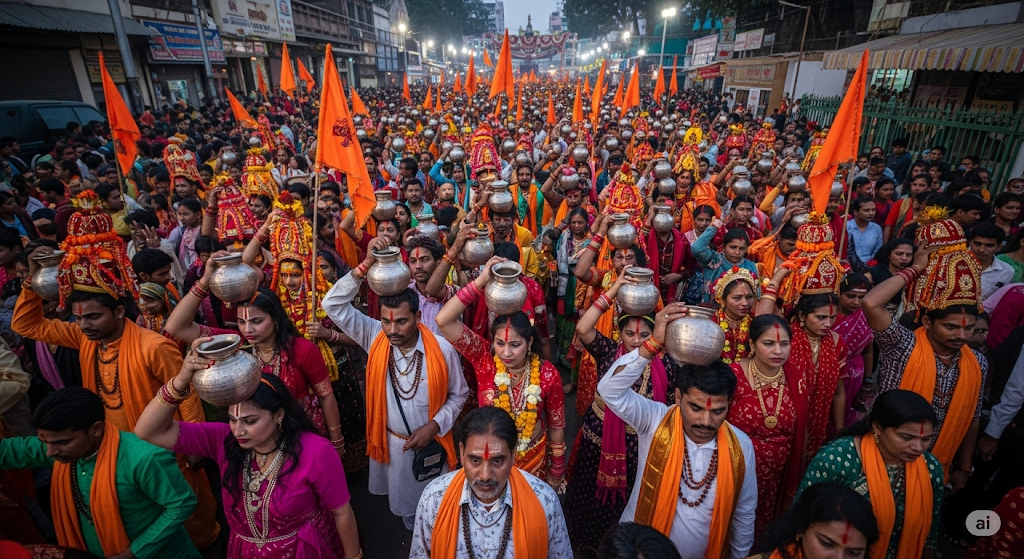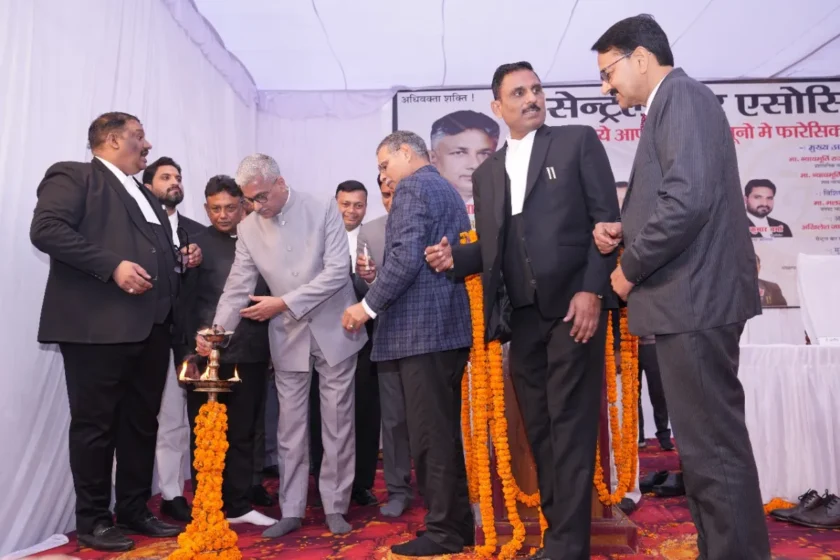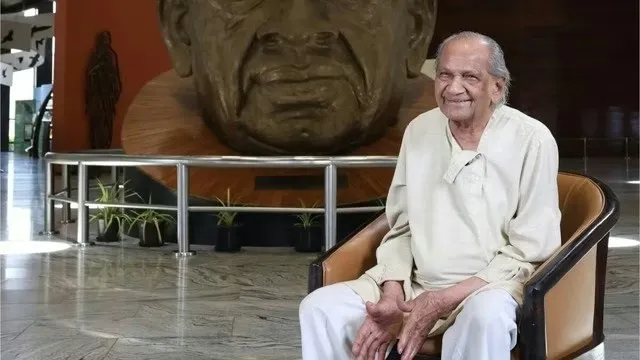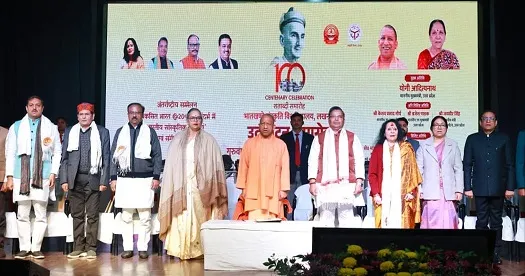Lucknow: As the skies grow heavy with monsoon clouds and the month of Shraavana begins, North India is enveloped in a spiritual phenomenon both ancient and intensely alive. The Kanwar Yatra—an annual pilgrimage undertaken by the Kawariyas, devotees of Lord Shiva—is in full motion, echoing chants of “Bam Bam Bhole” through riverbanks, highways, and rural trails.
The pilgrimage is reaching its peak ahead of Sawan Shivaratri on July 26. From Haridwar and Gaumukh to the distant ghats of Sultanganj and beyond, saffron-clad devotees are braving the rains, carrying holy water drawn from the sacred Ganges to offer at Shiva temples in their hometowns. The Kanwar Yatra is not just a ritual—it is an odyssey of faith, austerity, and unyielding resilience.
Spiritual Roots: The Mythology of the Yatra
The origins of the Kanwar Yatra are deeply embedded in Hindu cosmology. According to legend, during the Samudra Manthan—the churning of the cosmic ocean—Lord Shiva consumed the lethal Halahala poison to protect creation. To cool the immense heat he bore in his throat, turning it blue and earning the name Neelkanth, the gods poured Ganges water upon him.
The Kawariyas replicate this divine offering. With copper or brass urns—called kanwars—strung across their shoulders, they traverse hundreds of kilometers to collect Gangajal (Ganga water) and then pour it over Shiva Lingams, seeking blessings for themselves and their communities.
This year’s yatra began auspiciously on Thrayodashi, the 13th day of the lunar fortnight of Shraavana, amplifying its spiritual gravity. The roads, ghats, and temples are awash with devotion, the air thick with the scent of incense and the sounds of devotional songs.
The Journey Itself: A Path of Austerity and Endurance
The Kawariyas’ preparation for the pilgrimage is as disciplined as the journey itself. Many begin weeks in advance with a vow of purity—abstaining from meat, alcohol, tobacco, and all forms of indulgence. Even marital relations are paused. They sleep on the floor, rise before dawn, and observe satvik (pure) routines.
Clad in orange or saffron attire—colors of renunciation—they set off in groups, sometimes barefoot, their feet blistered but spirits undeterred. Some walk 300 kilometers from towns like Meerut or Baghpat; others, like those coming from as far as Jharkhand or Odisha, trek up to 700 kilometers. A group from Coimbatore made headlines this year, having traveled over 3,000 kilometers by foot and rail to reach the Ganges.
“The journey is hard,” says Lakhan Yadav, a 56-year-old Kawariya from Gwalior, “but we don’t feel the pain. Every step we take is a step toward Shiva.”
On the Road: A Moving Festival
The Kanwar Yatra transforms India’s roads into rivers of faith. Temporary camps and langars (community kitchens) are set up by volunteers and locals along major routes like NH8 and NH58. These centers offer food, medical care, and spiritual encouragement. The atmosphere is festive, with bhajans playing through loudspeakers and streets lit up at night like temple fairs.
“Villagers along the route treat it as their religious duty to support the pilgrims,” notes historian Suresh Dwivedi. “It’s not just a journey—it’s a traveling ecosystem of devotion.”
Interestingly, a relay system is also used for the return journey. Known as Dak Kanwar, this method involves relays of pilgrims or trucks carrying the Gangajal, ensuring its sanctity is preserved. Each team member treats the water with reverence, as though carrying a deity itself.
A Symbolic Kailash
Though the ultimate spiritual destination, Mount Kailash—the mythological abode of Lord Shiva—is inaccessible to most, the symbolic meaning of the Kanwar Yatra bridges that gap. As mystic Sadhguru puts it, “When we say ‘Abode of Shiva,’ we mean the inner space where his energy lives.”
The physical strain, the monsoon rains, and the collective rhythm of the walk become tools of inner transformation. For many Kawariyas, the yatra is not just a physical pilgrimage—it is a sacred inner passage to surrender, reflection, and rebirth.
Rituals and Reverence
The culmination of the yatra is marked by rituals both personal and public. After reaching home, devotees perform abhishek on the Shiva Lingam with the Gangajal, along with offerings of bel patra, milk, honey, and bhang. It is believed that this purifies not only the worshipper but also their family for generations.
At temples like Kashi Vishwanath in Varanasi or Baidyanath Dham in Deoghar, long queues of Kanwar pilgrims form from the early hours, creating a spiritual spectacle that connects the ancient with the present.
Contemporary Challenges
But the yatra is not without its complications. Over 10 million Kawariyas take part annually, with 2025 already witnessing a record-breaking turnout. This surge puts immense pressure on roads, sanitation, medical infrastructure, and law enforcement.

In 2023, an altercation in western Uttar Pradesh over route diversion turned violent, highlighting the need for better coordination. Traffic diversions, especially in cities like Delhi, Meerut, and Haridwar, result in inconvenience to locals and emergency services.
“The sheer scale of the event requires an all-government approach,” says Nitin Awasthi, a traffic control officer in Roorkee. “We respect their devotion, but safety and order are crucial.”
There’s also the rising concern over environmental degradation. The Ganges, already battling pollution, suffers further from the discarded plastic bottles, food waste, and ritual offerings during the yatra. The Uttarakhand government, in 2025, urged the use of eco-friendly items and reusable urns, but implementation has been patchy.
Digital Devotion and Changing Demographics
Technology has reshaped the yatra in subtle but significant ways. Social media is awash with selfies, reels, and drone footage of saffron processions under stormy skies. Hashtags like #KanwarYatra2025 and #BamBamBhole trend every day, blending old faith with new-age digital expression.
The profile of the Kawariya is also changing. Once dominated by rural male youth, today’s pilgrims include urban professionals, women, and senior citizens. A 2024 survey by the Ministry of Culture noted a 15% rise in female participants, many from cities like Pune, Bengaluru, and Lucknow.
Kamini Singh, a 35-year-old IT professional from Noida, participated in her first Kanwar Yatra this year. “I wanted to reconnect with something spiritual, something elemental,” she says. “This isn’t just a pilgrimage—it’s a pause, a reset.”
Voices from the Path
The heart of the yatra lies in its people. Bola, a teenager from Jabalpur, trekked 400 kilometers barefoot. “This water is my promise to Lord Shiva,” he said, holding up a small brass pot with both pride and trembling hands.
An 80-year-old woman from Alwar shared her story at a langar camp near Bijnor: “I’ve done this 20 times. Every year, I ask Shiva for one more year to come back. So far, he’s said yes.”
Their stories echo the mystic poet Basava’s lines: “Things standing shall fall, but the moving ever shall stay.” The Kawariyas’ motion is thus both physical and eternal—an undying testament to the power of faith.
Looking Ahead: Balancing Devotion with Sustainability
As the yatra expands, so does the need for thoughtful planning. The Uttarakhand government’s helpline (1800-180-5147), traffic advisories, and water stations are steps in the right direction. Proposals for a “Green Kanwar Yatra”—with biodegradable materials, waste segregation, and better crowd management—are gaining momentum.
Meanwhile, Supreme Court directives in 2024 have called for strict law enforcement to ensure that devotion does not override civic responsibility. Religious leaders, too, are stepping in, urging restraint, cleanliness, and compassion among devotees.
Shiva in Every Step
The Kanwar Yatra of 2025 is more than a pilgrimage—it is a movement. One that carries within it not just the physical water of the Ganges, but centuries of myth, meaning, and human perseverance. It is an embodiment of bhakti in motion, a chorus of millions marching toward the intangible abode of Shiva—not high in the Himalayas, but in the sanctified space of their own hearts.
As twilight falls on yet another day of the yatra, and the chants of “Bol Bum” echo across riverbanks and city highways, one thing becomes clear: this is a tradition that lives, breathes, evolves—and continues to inspire, one sacred step at a time.





